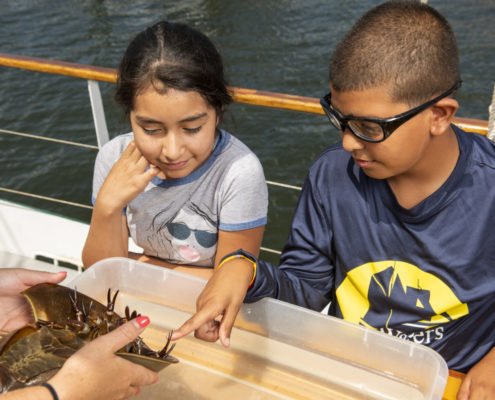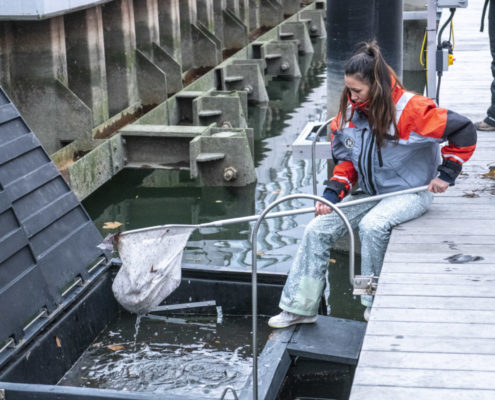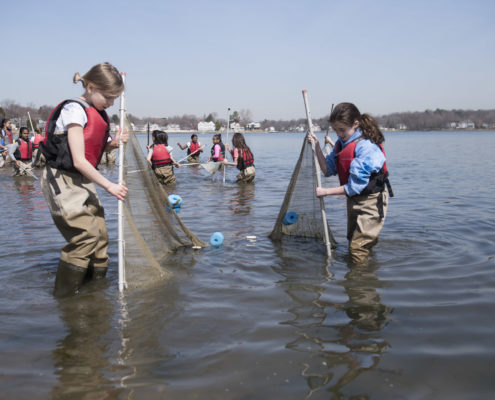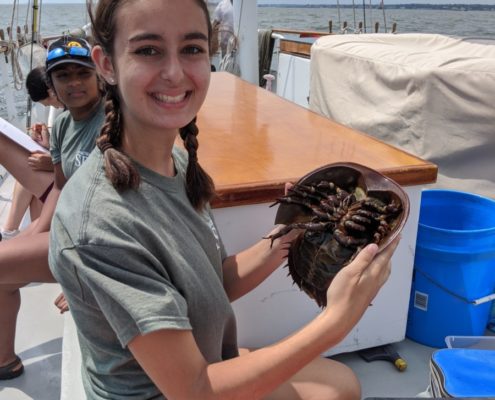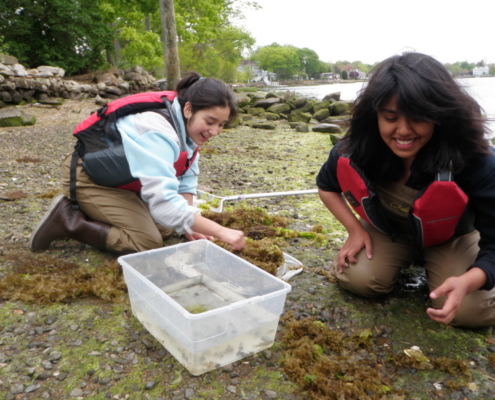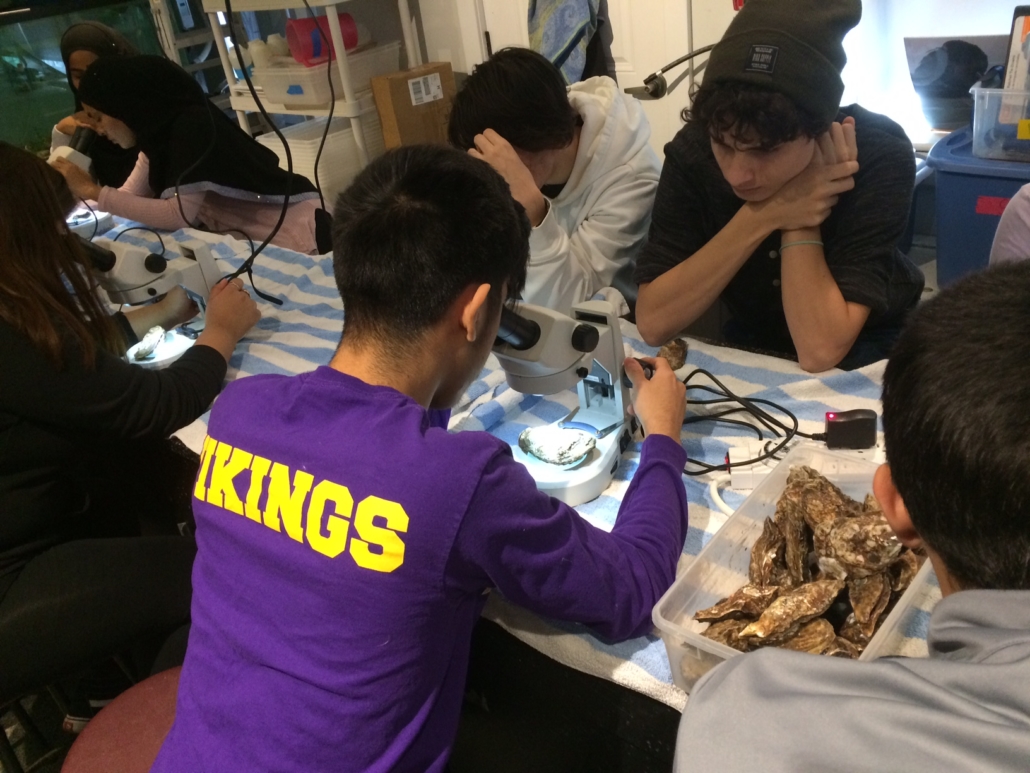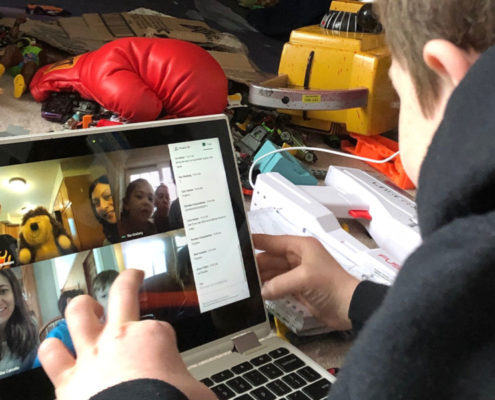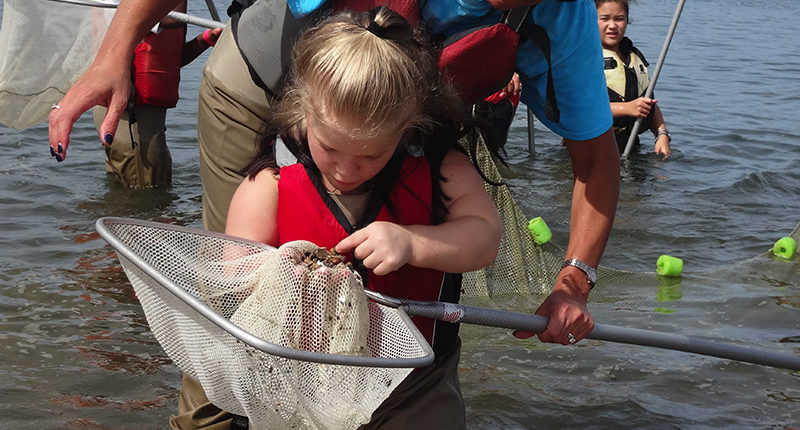Elementary School Virtual Field Trips
Science on the Sound
Embark on the iconic Schooner SoundWaters, a beautiful three-masted sailing ship, to explore the deep waters of Long Island Sound. Students will study the bottom dwelling animals, called benthic organisms, and explore the important body systems of these animals. They will learn about the adaptations these organisms have to help them survive in the depths of Long Island Sound.
Following a benthic ecosystem trawl, students will dive into the following topics:
- Long Island Sound Food Chain: Learn all about the different levels of the food chain as well as Long Island Sound examples of each level.
- Digestive System: Perform an in-depth analysis of the digestive system of common benthic marine organisms.
- Circulatory System: Discover the differences between an open and closed circulatory system. Each is unique and necessary to keep animals healthy!
- Aquatic Movement: There are so many ways aquatic animals move! Observe examples in action with our Long Island Sound animals.
- Animal Senses: Senses are of key importance to the wellbeing of all organisms. Explore the ways in which animals sense the world around them.
Humans & Our Environment
Come aboard the SoundWaters Research Vessel for an in-depth analysis to understand one of the most prominent issues affecting Long Island Sound: human impact. Students will become empowered to make a difference in their community and learn how they can help to improve the health of Long Island Sound.
Topics include:
- Marine Debris: Marine debris comes in many forms: plastic bottles, Styrofoam, bottle caps, the list goes on. Learn about the ways in which this debris enters the water and some of the impacts it can have on the environment.
- Microplastics: These tiny pieces of plastic are found all over, they even used to be in our toothpaste! Discover where they come from, the harm they can cause the environment and what you can do to help.
- Runoff: Runoff comes from many sources and brings different types of pollutants to Long Island Sound. Observe a few sources and the repercussions run off can have on the environment.
- A visit to the SoundWaters Marina Trash Skimmer, an active marine debris research project.
- An introduction to the student-led Million Bottle Cap Challenge.
- Renewable Energy: Engineers are constantly developing new technologies to benefit the environment. Come along on a scavenger hunt to find examples in Cove Island Park.
- Remediation: Humans have had many impacts on the environment. Explore the ways in which we are able to remediate our impacts.
Coastal Field Study
Strap on your waders and get ready to explore the coastal habitats of Long Island Sound. Join our Educators in the field discovering the variety of ecosystems at the SoundWaters Coastal Education Center in Stamford, CT. Students will learn the importance of each habitat found along the coast of Long Island Sound as well as the adaptations plants and animals have developed to survive there. They will come to understand the effects the nonliving components of the ecosystem can have on the plants and animals living here.
Topics include:
- Coastal Habitats: Coastal habitats play such an important role in the lives of many marine species living in Long Island Sound. Discover the plethora of coastal habitats found in Cove Island Park. Plunge into the significance of each habitat for the animals that rely on it.
- Introduction to Animal Adaptations: Educators lead students through an in-depth analysis of two types of adaptations: behavioral and physical. Venture out to the habitats of Cove Island Park to learn about some specific adaptations animals in Long Island Sound use to survive and thrive here.
- Biotic and Abiotic Factors: An ecosystem is a combination of all the living, or biotic, and nonliving, or abiotic, things in an area. Students will explore the ways in which abiotic components of an ecosystem can affect the biotic components through relevant Long Island Sound examples.
- Coastal and Marine Plants: While plants have the same requirements to grow wherever they live, they face different challenges. A plant growing near the water or in the water has different adaptations to live than those growing inland. Learn about a few plants commonly found on the coastline and the adaptations they have to survive.
- Tides: Sometimes there’s a lot of water and sometimes there isn’t! The tide is a driving force in the movement of water in Long Island Sound and around the world. Take a deep dive into the science behind the tides.
- Freshwater Bioindicators: The health of Long Island Sound is largely dependent on the health of its fresh water inputs. Pollution from upstream can have a negative impact on the Sound. Gear up to assess the health of the Mianus River, a direct tributary of Long Island Sound.
Video Lesson (45 minutes)
Student Worksheet
Teacher Guide
Middle School Virtual Field Trips
Science on the Sound
Adventure on the iconic Schooner SoundWaters, a three-masted sailing ship, to the depths of Long Island Sound. Students will study the community of benthic organisms and learn about the adaptations their body systems have to life down below.
Following a benthic ecosystem trawl, students will learn the following topics:
- Food Web: Animals need to eat! Learn about the intricacies of Long Island Sound food web.
- Digestive System: Explore the unique digestive systems of four marine organisms. Understand the differences and significance of each.
- Vascular System: Organisms have specialized vascular systems to transport materials around the body. Discover the distinction between the systems of a few different marine animals.
- Aquatic Locomotion: Animals have adapted and developed a number of ways to move around their environment. Educators will identify some examples commonly found in Long Island Sound.
- Animal Senses: Being able to sense the environment is crucial to the survival of a species. Distinguish between the different receptor types – chemoreceptor, auditory receptor, mechanoreceptor & photoreceptor – used by marine organisms.
Humans & Our Environment
Mankind has been linked to the water for thousands of years. Come aboard the SoundWaters Research Vessel to perform an in-depth study into and analysis of one of the most prominent issues affecting Long Island Sound: human impact. Through examples and observations, students will become empowered to make changes in their community to better the health of Long Island Sound.
Topics include:
- Marine Debris: Debris makes its way into Long Island Sound through both point and nonpoint pollution sources. Analyze the ways in which this debris can break down – photodegradation and biodegradation – and the impacts it can have on the environment.
- Microplastics: Microplastics are found all over! Learn about their origins and the effect they can have on the Long Island Sound food chain.
- Runoff: Runoff is a big issue in the Long Island Sound, largely due to the number of people that live along its shores. Explore the effects it has on the environment and organisms that call Long Island Sound home.
- A visit to the SoundWaters Marina Trash Skimmer, an active marine debris research project.
- An introduction to the student-led Million Bottle Cap Challenge.
- Renewable Energy: Engineers have been working to develop new technologies to generate renewable energy. Learn about some common examples through a scavenger hunt in Cove Island Park!
- Remediation: Humankind has been impacting the land in many ways for thousands of years. Observe examples of the ways in which scientists have been creating positive change for the environment.
Coastal Field Study
Strap on your waders and get ready to explore the coastal habitats of Long Island Sound. Join our Educators in the field discovering the variety of ecosystems at the SoundWaters Coastal Education Center in Stamford, CT. Students will learn the importance of each habitat found along the coast of Long Island Sound as well as the adaptations plants and animals have developed to survive there. They will come to understand the effects the nonliving components of the ecosystem can have on the plants and animals living here.
Topics include:
- Coastal Habitats: Estuaries are some of the most productive ecosystems on Earth. The habitats found along the shore of Long Island Sound are very important to maintaining the diversity found in the Sound. Venture out into Cove Island Park to explore the various habitats and learn about the significance of each.
- Adaptations Overview: Investigate three types of adaptations: physiological, structural and behavioral. Uncover the mystery behind one of Long Island Sound’s oldest animals, how has it been able to survive for so long?
- Biotic and Abiotic Components: An ecosystem is made up of biotic and abiotic components. Abiotic factors can influence the biotic factors and vice versa. Dive into some of these interactions to learn about their lasting effects.
- Coastal and Marine Plants: Plants living along the shore face different challenges than those that grow inland. Coastal and marine plants have developed specific adaptations to overcome these challenges. Spread your roots to analyze the variation found in coastal and marine plants and the importance they play in the ecosystem.
- Tides: Water in Long Island Sound is constantly in motion, largely due to the tides! Plunge into the science behind tidal movement and the influence it has on the animals of Long Island Sound.
- Freshwater Bioindicators: The Long Island Sound is only as healthy as its tributaries. Pollution coming down rivers can have a negative impact on the Sound. Wade into the Mianus River with our Educators to perform a bioassessment of the river and determine its health.
Video Lesson (45 minutes)
Student Worksheet
Teacher Guide
High School Virtual Field Trips
Climate Science
The Climate Science series is a five lesson, high school-level exploration of the causes, impact and effects resulting from earth’s changing climate. SoundWaters Educators guide students through some of the complex topics relating to this important subject, explaining the chemistry and physics at work and how they impact humans, the natural world, oceans, and Long Island Sound. Importantly, students also examine options for remediating and mitigating the adverse effects of a warming planet.
We strongly recommend students begin by viewing Greenhouse Gasses, as that sets the stage for the other videos. The series can be completed by students working independently and will also fit well into the classroom context.
Topics Include:
Greenhouse Gasses
Ocean Acidification
Ocean Warming
Sea Level Rise
Climate Resilience
NGSS Alignment:
HS-ESS2-2 Earth’s Systems
HS-ESS3-6 Earth and Human Activity
Video Lesson (45 minutes)
Student Worksheet
Teacher Guide
Live Zoom Sessions
Schools and other groups can book a private live virtual program using Zoom. The programs will be streamed live to allow for questions and answers and for adaptations to specific curriculum needs. The programs also can be recorded for later viewing; for example, by a student who missed the live stream.
Meet your education team (click on the Education tab)
Programs are 45-60 minutes including Q&A, with a limit of 25 participants per session.
Program cost is $250 per session. Scholarships are available.
Live sessions are available Monday – Friday 9am – 3pm.
If you have questions or want to book a Live Zoom Session, email Olena Czebiniak or call at 203 406 3319


